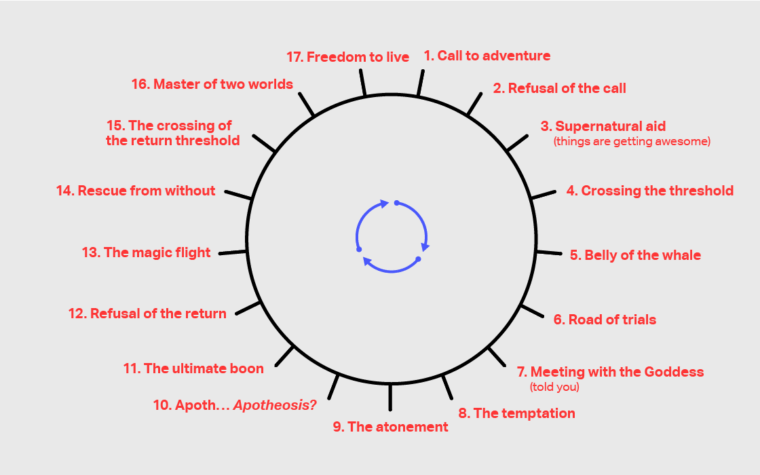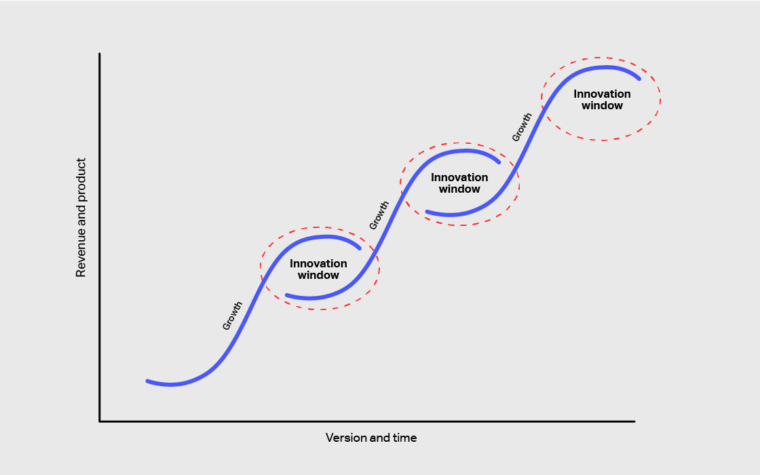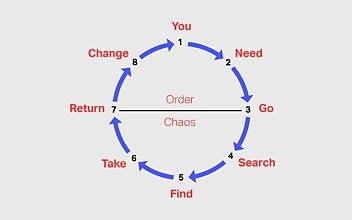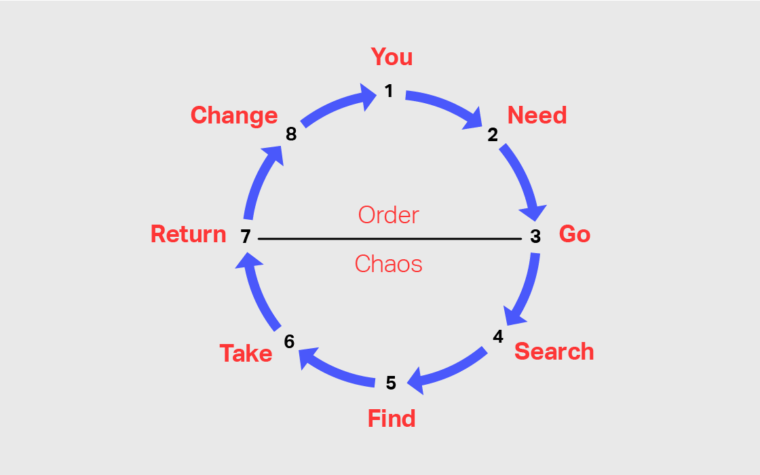The problem with the ‘customer journey’
We often refer to the ‘customer journey’. It’s a nice idea, but a problematic one. There’s a reason that Doug made it one of his Three Poisonous Metaphors.
Normally when we talk about a customer journey, we’re not really talking about the customer. We call it their journey, but assume that we are the destination.
That thinking relegates the customer to the second player in their own journey.
Really, with that thinking, we’re talking about ourselves.
I think there’s a lot of merit to the idea of a customer journey. We just need a better definition of what that journey actually is.
And luckily, I think there’s a framework we can already apply.
(Now, full disclosure, this is not a short read. But it is an important one. I’m going to try and get to the root of what a story is, and that takes a few words. But there are three pictures along the way, so it’d be like 3000 words longer without them.)
The monomyth (or hero’s journey)
As long as there’ve been stories, there’ve been people trying to fit them into a formula. This is the impressively-named monomyth, with the most famous example being Joseph Campbell’s The Hero with a Thousand Faces.
In his version Campbell set out seventeen steps that, theoretically, every story would fit into. Including steps with esoteric names like “Apotheosis” and “Meeting with the Goddess”. It looks like this:

As confusing as it looks, it’s influenced a lot of people over the years. For instance, George Lucas actively followed the structure when making Star Wars (which seemed to work out OK for him).
But Campbell’s version of the monomyth isn’t my favourite. There’s a simpler version (thankfully).
Dan Harmon’s story circles
Dan Harmon is a writer and the creator of shows like Community and Rick & Morty. I think his story circles are an incredibly powerful distillation of the monomyth.
I think there’s a lot we can learn from it as marketers. But before we get into that, let’s look at what it actually is.
It’s only eight steps (take that Campbell). And it looks something like this:
That’s pretty much every story ever written.
In practice, it might look like this:
Luke (You) has to save the Rebellion (Need), so he flies off with Obi-Wan, Han and Chewie (Go), looks for Leia (Search), finds her (Find), frees her from the Death Star while paying the price of losing Obi-Wan (Take, and, erm, *spoiler warning*), goes back to the ‘normal’ non-Imperial world (Return), then uses everything he’s learnt to blow up the Death Star (Change).
A story has to hit those steps. If it misses some it just doesn’t… feel right.
You can start a story, but not resolve it: “Luke is on a planet and flies off to join the Rebellion”. So what happens then?
And you can have the most exciting part of the story, but without the rest, it’s not grounded: “A guy in a spaceship destroys a much bigger space ship.” So why should I care?
And it’s not just blockbuster movies that use this structure. In theory, every story ever written can be broken down into these steps.
Have you ever had that thing at a party where someone starts telling a story and you expected it to continue even after they stop? That’s probably because they didn’t complete the story circle.
The customer journey
So what the hell does this have to do with B2B marketing?
Well, this is the universal story. Every journey follows this structure. Including customer journeys.
And that’s because all good stories are about transformation. Becoming something that you weren’t before, doing something in a different way to how you used to. Learning. Growing. Changing.
By definition, when a customer pays you money, they expect to be better for the transaction. Better than they would have been without you (otherwise what was the point?)
Sure, the exact details of their journey can be as different as Star Wars is from Die Hard, or Sleepless in Seattle, but the journey is the same. And there’s a lot we can learn from it.
Let’s take a look at how this works for a customer.
1) You – Our protagonist is that potential customer. They’re happy, comfortable. Life is good.
2) Need – But…something is wrong. Something’s missing in their life (well, work). They may come to this realisation on their own, or it might be because we point it out to them (thank you, marketing budget). But either way, they’re aware that something isn’t quite right.
3) Go – They decide to find a solution to this problem.
4) Search – They’re looking for an answer. They’ll consider anything (which may or may not work for them). It might be you. It might be your competitors. Or it might be something else entirely.
Then there’s the chance they’ll find an internal work around. Or simply decide to do nothing and end their journey here. Luke stays at home farming moisture (yeah, that was his job) like some chump, unaware of the transformation he could have had if he’d seen the journey through.
5) Find – They find the option they think is best.
6) Take – They take it, and pay a price. There’s the literal price, but also other kinds of price too. There’s the time and effort of learning something new, there’s the opportunity cost of fixing this over the other things that time and money could have been put into.
And there’s the biggie of internal social currency – if someone is going to put their neck out to recommend a big purchase to their boss, they want to know it’s worth it.
7) Return – They move back into their world of comfort, taking their new tool and way of thinking with them, and slowly re-adjust to life.
8) Change – It’s part of who they are now, and they’re much the better for it. Now they can be even better at what they do best.
What we can learn from this
I think there are four key takeaways from applying story circles to our customers:
- Every customer journey hits those steps – but where we join in may vary
It can be easy to think a customer’s journey starts when they meet us.
It doesn’t.
In all likelihood by the time they get in touch with us, they’re already on step 4. And buying is only step 6. That means the ‘traditional’ customer journey from meeting to sale only actually covers three out of the eight steps.
But just as importantly, the way we talk to customers at different stages will vary too.
The way we treat a customer who’s happy enough with their system (You), vs just about to sign on the dotted line with a competitor (Take), vs just finished a new implementation (Change) will be hugely different.
But if we can work out where they are, we can work out how we can help.
Here’s what we might say:
You – What matters to you?
Need – What’s preventing you or your team from having more of that?
Go – Where do you go when you’re looking for an answer like this?
Search – Here are some other options people might suggest, and why they don’t quite work for you.
Find – Oh, by the way, here’s our answer.
Take – Wonderful! But get ready for some big changes.
Return – How can we help you to hit the ground running?
Change – In the new world, there are a whole new range of best practices to think about.
- Order vs chaos – comfort vs discomfort
The second big takeaway from this journey is that line in the middle. That’s the line between the familiar and the unfamiliar.
In classic stories that might be our hero leaving their sleepy village to a world of magic, the beat cop who finds himself at the centre of a huge conspiracy or a stuck-in-their-ways protagonist whose life is changed by meeting a happy-go-lucky character.
They’re taken from what they know (or thought they knew) into something else.
In B2B marketing that line in the middle represents the potential customers comfort zone. The boundary of their experience, where they’re moving into an area they don’t know.
The cool thing is that, very often, that happens to be an area we know very well.
This doesn’t have to be a drastic pivot, it’s simply a new area with new problems and opportunities. They need some guidance.
They’re probably highly intelligent, but simply unaware of what you offer at that stage. It’s an unknown unknown, or some such thing.
The right guidance, the right support, makes all the difference.
- The journey doesn’t end when they find what they need
It’s tempting to think that when we’ve made the sale, that’s it. Job done. Where’s my commission?
But there’s still more. We need to make sure the purchase works for our customers. That they get set up, work through the pain points and become better than they were before.
It used to be that a huge on-premise server system or IT infrastructure was enough of a sunk cost that people would have to learn how to use it. Any problems they had were their problem.
Now? Changing cloud suppliers can be as simple as a few clicks.
Providers need to put the work in to make sure customers stick around. Those per-user fees need time before they become profitable.
On our story circle, there are two steps after customers pay. Get them wrong, and their journey won’t have ended yet.
You’ll be the hapless it’ll-never-work-out love interest that shows them what really matters before they settle down with their true love at the end of act 3.
- There’s a reason it’s a circle
It’s important that the journey is a circle. It doesn’t end, it just goes back to the beginning.
Yes, if they don’t get on with their new solution, they’ll look for a new one. But even if they do love you, is your offer completely future-proofed?
Unless you keep innovating, eventually someone will come along who offers something you don’t. Or the customer will discover some need that they’ll go searching for an answer to.
It’s the S curve of innovation:

Something new will come along. It always does.
But if you’re the one bringing them that innovation first? They’ll never need to go looking for an answer, as you’ve given it to them before they even had the question.
And even if they do beat you to it, if you set them up correctly, and follow up often enough, when they go looking for an answer, you’ll be their first call.
B2B Heroes
It can be easy to think that customer journeys start when they first get in touch with us. But in reality a lot happens before – and after – that.
Story circles are a great way to focus in on the truth about what the real customer journey is.
A journey doesn’t need explosions, excitement or glowing swords of death. A journey is someone who has a problem and is looking for a solution.
It’s that simple.
And story circles can be a useful reminder that the journey’s happening whether we’re part of it or not.

Enjoyed this article?
Take part in the discussion









Comments
David Locke May 15th, 2018
The S-curves would not have the same slopes.
Craig Beadle May 21st, 2018
Thanks David – tried to keep it simple this time (that, and the thought of varying the incline gives me anxiety flashbacks to using gym treadmills)
Michael LaRocca, Business Editor Michael Edits May 18th, 2018
Yoda, I am. Luke Skywalker, my customer is. Before it all went down the gurgler in the new trilogy, I mean.
Craig Beadle May 21st, 2018
Yeah, I don’t think ‘more details on galactic trade negations’ were in anyone’s Need category.
Patricia Salem Seaside Scribe May 20th, 2018
I loved this! Found you through Win Without Pitching. I am a fiction writer at heart, so using storytelling technique to explain myself, to understand the customer’s journey, and to execute their needs as a writer is perfect. I really liked the idea of reframing the customer’s story to make it about them and not the content provider. “What’s preventing you from having more of that?” The obstacle is always the heart of the story. Brilliant.
Craig Beadle May 21st, 2018
Thanks so much Patricia! May your fiction-writer heart and copywriter brain combine and take you to incredible places
Karla B2B January 2nd, 2020
Hello,… Besides the classic work of Joseph Campbell I really like the author James Mcsill, you know? Worth the read. I really enjoyed the perspective you gave in the post, congratulations!
Doug Kessler January 3rd, 2020
Thanks, Karla — will check him out.